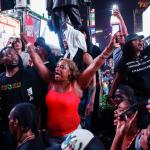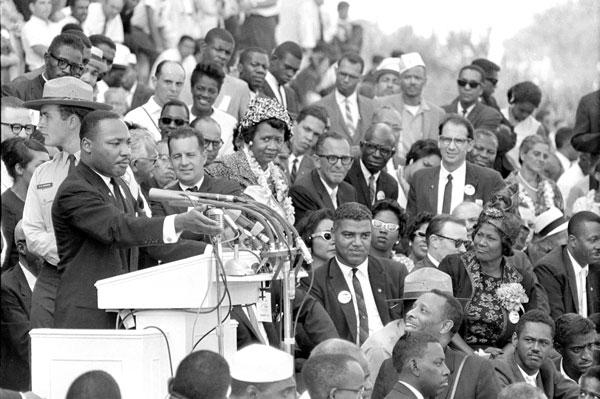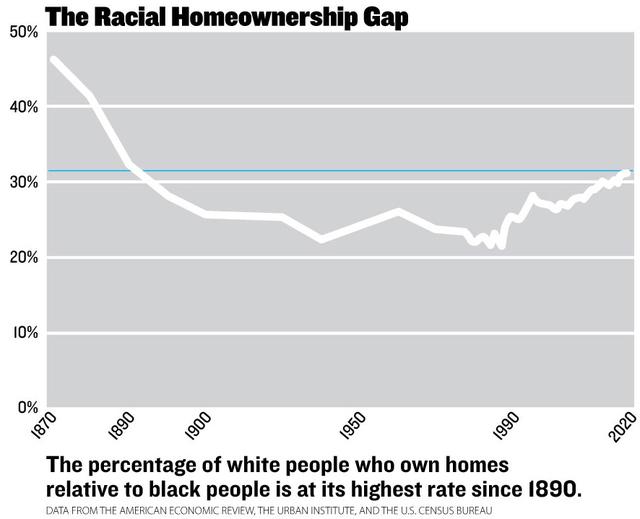No Justice. No Peace.

During the era of redlining, race was the number one metric used in determining which areas were deemed “Hazardous” and which areas were marked “Green: Best” or “Blue: Still Desirable.” White neighborhoods were green and black ones were red. The red neighborhoods could not qualify for Federal Housing Administration mortgage guarantees, which was the biggest wealth-building subsidy of the century, or as Ira Katznelson has called it, “white affirmative action.” Redlining would lead to massive wealth disparities, and radically different opportunities for white communities and black ones.
White suburbs created not just individual wealth for white families, but community wealth and social capital. Schools were better funded, parks were built, and public spaces were clean and plentiful. Much of the funding came through local property taxes, and therefore indirectly from the subsidy given to white families, employed subsequently to improve their quality of life. In the redlined black ghettos, by contrast, schools were underfunded, municipalities went bankrupt, and highways were sent right through the middle of the neighborhoods. But one department that was not underfunded was police. In fact it was paid for through the implicit demands of white taxpayers, who sought to keep the ghettos surrounded and their enclaves protected. Like police kettling that encircles protesters and offers no means of escape, black communities were caged, surveilled, and infiltrated. Formerly redlined areas became heavily policed opportunity deserts, with researchers making clear links between poverty, race, and police killing.
The city of Ferguson, Missouri, erupted after police killed Michael Brown, a black man, in 2014. This was one of the largest race riots the country had seen in recent years and it marked the genesis of the Black Lives Matter movement. Ferguson was a suburb of St. Louis, which was one of the most segregated cities in the United States. It was created by the exodus of black residents from the newly gentrified inner city of St. Louis. Ferguson’s population was two-thirds black and predominantly low-income, with more than one-fifth of the residents living below the poverty level. The subpar schools were almost completely segregated: 30 percent of blacks there were unemployed compared to 6 percent of whites.
During the Michael Brown protests, rioters destroyed white-owned commercial property. The National Guard was dispatched and Americans watched as demonstrators burned cars and buildings and police in military gear descended upon the city, enforced a curfew, and eventually quelled the protests. When Fox News interviewed one looter, he explained that the message the city had sent to its black residents was “We’re gonna eat and you guys are gonna starve.” He replied, “It’s not gonna happen. Not in St. Louis.”
The following year, Baltimore exploded. A Harvard study found that Baltimore was the nation’s worst city with respect to childhood poverty and lack of economic opportunity. It was also one of the most segregated cities in the country, and the financial crisis had created an acute foreclosure crisis there. The financial crisis of 2008 wiped out 53 percent of black wealth, after subprime lenders targeting black communities offered the worst the subprime market had to offer. Former congressman Brad Miller called it “an extinction level event.” Wells Fargo agreed to a $175 million federal settlement over housing discrimination allegations that black people in Baltimore were subject to “reverse redlining”: intentionally targeted for predatory lending and home equity extraction.
In 2015, Baltimore was the scene of a large-scale uprising after the funeral of Freddie Gray, who died of spinal injuries while in police custody. What began as a peaceful protest turned violent when rioters looted a CVS and destroyed a police vehicle. Soon, fires engulfed the downtown business area. “It’s regrettable, what’s happening now,” said the Rev. Jesse Jackson to The Baltimore Sun. “You’re looking at the actions of cynicism and hopelessness.” Gov. Larry Hogan called a state of emergency and about 5,000 state and national law enforcement officers descended on the city and quickly put an end to the riots.
Half a century earlier, there were the riots of 1967 and 1968—Minneapolis being one of the cities that erupted in rage. President Johnson was caught between black-led violence from the ghetto and a growing conservative backlash. According to a White House adviser, he was left with no recourse but to “set up a commission and say a prayer.” The Kerner Commission Report, first titled “The Harvest of American Racism,” relied on hundreds of researchers who collected testimonies and statistics, and it was the first thorough governmental exploration of black economic disparity.
The final report determined that the riots stemmed from poverty, racism, inequality, and other social ills, but that the underlying cause was segregation. “Segregation and poverty have created in the racial ghetto a destructive environment totally unknown to most white Americans,” the report said. “What white Americans have never fully understood—but what the Negro can never forget—is that white society is deeply implicated in the ghetto. White institutions created it, white institutions maintain it, and white society condones it.” The report was an unapologetic excoriation of white society, which the commission deemed guilty not just of racism, but of apathy toward black poverty.

In his landmark “I Have a Dream” speech, Martin Luther King Jr. framed the black American claim to justice as rooted in a broken promise. AP Photo
The report ultimately warned, “Our Nation is moving toward two societies, one black, one white—separate and unequal.” The report advised a large-scale government program of integration and wealth-building for black communities.
The Kerner Commission report is particularly important now because it marked the closest the United States ever came to a public admission of wrongdoing or “truth and reconciliation.” It also looked at the root cause of a domestic uprising and it pointed its finger directly at the quiet white suburbs, the ones not rioting in the summer of 1967, the ones terrified and confused by what was happening over there in the segregated black ghetto. Ultimately, the report was more truth than reconciliation. Johnson all but ignored its findings and later explained that it was a matter of funding. “That was the problem—money.”
The Kerner Commission report was released in February 1968. On March 31, Johnson stunned the nation by revealing that he would not seek re-election. Martin Luther King Jr. was killed four days later, while he was still in the midst of his Poor People’s Campaign. During that summer, as racial unrest heated up, Nixon promised law and order on the campaign trail and won the election based largely on anti-black dog whistles.
We are still living in Nixon’s America, and the country remains divided along economic lines. The common thread between the Kerner Report and the flashpoints of police violence and black protests in the 21st century is the continued lack of economic opportunity in communities of color. While white people have flocked to Black Lives Matter protests this summer, that performative gesture does not fully reckon with the roots of white privilege: the abundance in their bank accounts, relative to their fellow black Americans.
Today, black families have an average net wealth of $11,000 compared to a white family’s average of $141,900. Pew Research Center data reveals that white families have 13 times more wealth than black families. The wealth gap exists at every income level, with a third of black families having no assets at all. The perpetuation of poverty is stunning—75 percent of black children who grow up in families in the bottom wealth category remain in that same category as adults. A 2013 study found that for white families, every additional dollar they earn in income leads to $5.19 in wealth. For black families, each dollar creates only 69 cents in total wealth. This growing divide perpetuates injustices hard to capture in the latest news of riots and protests. The racial wealth gap is where past injustice breeds present suffering.

Full justice demands a recognition of the historic breach of the social contract between America’s constitutional democracy and black Americans. And contract breach, as all first-year law students learn, requires a remedy. The post–Civil War 13th, 14th, and 15th Amendments to the Constitution promised freedmen equal protection under the law, the end of coerced labor, and the right to vote. All these promises became empty and effectively void almost immediately after they were made. If we envision these rights as a binding contractual promise, we can also envision a justification for a remedy to this breach.
In his landmark “I Have a Dream” speech, Martin Luther King Jr. framed the black American claim to justice as rooted in a broken promise, “a promissory note to which every American was to fall heir. … promise that all men … would be guaranteed the unalienable rights of life, liberty, and the pursuit of happiness.” King said that “America has defaulted on this promissory note insofar as her citizens of color are concerned. Instead of honoring this sacred obligation, America has given the Negro people a bad check … which has come back marked ‘insufficient funds.’” Continuing in the framing of a broken contractual obligation, he lays claim to a remedy: “e’ve come to cash this check, a check that will give us upon demand the riches of freedom and the security of justice.” No justice. No peace.
Black families have an average net wealth of $11,000 compared to a white family’s average of $141,900.
If the promise of equality was made by the federal government and then breached, what recourse can be envisioned for black Americans? Typically, claims of redress are called “reparations.” Viewed through the lens of contractual breach, reparations are akin to “damages.” Constitutional rights are not treated like typical contractual claims, but this framing can help us understand why a remedy is necessary for centuries of racial oppression and how one can be designed. Black Americans have been harmed in direct contradiction to the Constitution’s promise of equal treatment, yet they have still had to contend with its demand of equal treatment in seeking a remedy. In fact, as Justice Thurgood Marshall explained, the Constitution demands redress. “Measured by any benchmark of comfort or achievement, meaningful equality remains a distant dream for the Negro.” Marshall pleaded that “bringing the Negro into the mainstream of American life should be a state interest of the highest order” and warned that a “ to do so is to ensure that America will forever remain a divided society.”
While the civil rights reforms ended explicit racial segregation and Jim Crow, the effects of those policies have never been addressed. Instead, policymakers have repeatedly proposed self-help solutions rooted in the false assumption that a wealth gap created by a failure of public policy could be remedied by private markets. Every president since Nixon has championed one form or another of black capitalism to promote black banks and businesses, through tax credits and enterprise zones and other means of self-help. While these programs provided tax relief for asset holders, the racial wealth gap grew into a chasm.
Without major structural reforms, the wealth gap will continue to expand. A 2016 study glibly predicted that based on the current racial wealth gap, it would take 228 years for blacks to have as much wealth as whites today. The prediction, though grim, is based on a false assumption: that the wealth gap will naturally close over time—albeit a very long time—without intervention. In fact, as my previous research demonstrates, it is likely that the racial wealth gap will remain in place and continue to reproduce itself. In other words, if nothing changes, no amount of time will close the wealth gap, because of the self-perpetuating effects of capital accumulation. The prediction of 228 years of stagnation also underestimates the transformative effects of policy changes that could close the racial wealth gap quickly. Heretofore untried changes can close the wealth gap very quickly.
Full justice demands a recognition of the historic breach of the social contract between America’s constitutional democracy and black Americans.
The essential first step in dealing with the wealth gap is to acknowledge that public policy created it and must be used to address it. Once we’ve overcome this step, the rest is relatively straightforward. The first step, as Sandy Darity and Kirsten Mullen point out in their new book, would be for Congress to convene a hearing to study the program. Despite years of advocates asking for some type of hearing, Congress has yet to schedule one. This is not surprising. Hundreds of proposals over years where it actually could have saved lives have been slow-walked; Congress passed its first anti-lynching bill in 2018, and another has been held up in the Senate.
Often when reparations are brought into polite conversation, opponents react skeptically, claiming “impracticability.” Yet courts often make damages determinations purely out of thin air for suits on patent violations, product liability, personal injury, and shareholder class action suits. Opioid drugmakers, tobacco companies, and oil companies have had to pay hundreds of billions in damages to remediate environmental damage, the harms of lung disease, and an overdose epidemic. So it seems possible to determine a fair remedy for black communities for slavery, Jim Crow, redlining, segregation, police brutality, and other harms of discrimination.
Typically, contract damages are an attempt to make the breached-upon party whole. Just one way to achieve justice, as I’ve outlined in a recent law review essay, is to focus on outcomes rather than means, with a focus on closing the racial wealth gap. For example, reparations could mean that the federal government could enlist several programs and agencies at once, intended to eliminate the racial wealth gap. The means of elimination would be flexible so long as within a stated amount of time, the wealth gap was eliminated. Several other government programs are designed in this way. For example, the Congressional Budget and Impoundment Control Act of 1974 created the Congressional Budget Office (CBO), tasked with analyzing congressional bills and agency programs with a focus on cost-cutting. The CBO has a mandate to score each bill and use a cost-benefit analysis. This score is put to use when passing the bill. A similar oversight committee can be devised to score each bill and agency program on its effects on the racial wealth gap. Closing the racial wealth gap can be viewed as a specific regulatory goal and each agency can design their own program or response depending on their own specific domain. The racial wealth gap has deleterious effects on black communities in practically every domain: environmental impact, education, credit availability, housing, and policing. Thus, a response must be multifaceted.
Madison called slavery “America’s original sin.” The sin has grown and festered and continues to infect our politics. C. Vann Woodward explained how white supremacy and Jim Crow destroyed the soul of the South. Racism destroys the soul of its perpetrators as it plunders the labor and the bodies of its victims. Frederick Douglass speaks of how he watched as the white woman who purchased him was ruined by slavery. He writes vividly about what it cost her to justify owning another human:
Slavery proved as injurious to her as it did to me. When I went there, she was a pious, warm, and tender-hearted woman. … She had bread for the hungry, clothes for the naked, and comfort for every mourner that came within her reach. Slavery soon proved its ability to divest her of these heavenly qualities. Under its influence, the tender heart became stone, and the lamblike disposition gave way to one of tiger-like fierceness. … That cheerful eye, under the influence of slavery, soon became red with rage; that voice, made all of sweet accord, changed to one of harsh and horrid discord; and that angelic face gave place to that of a demon.
Racism, its aiders and abetters, its justifiers, the cops, the white moderates are all sick with this rot at the core of our democracy. It must be rooted out and addressed. It must be held out to the light, examined honestly, and properly dealt with. For the sake of black Americans—for the sake of the American soul. It is time to atone for this country’s original sin. No justice. No peace.
Mehrsa Baradaran, a professor of law at UC Irvine School of Law, is author of ‘How the Other Half Banks’ and ‘The Color of Money.’ She is a Prospect board member.
